 Archaeologists have discovered a massive treasure from a 17th century shipwreck in Meishan City in the Sichuan Province of southwest China. The ship sank where the Jinjiang River branches off from the Minjiang River in 1646, and with it plunged more than 10,000 gold, silver and bronze coins, ingots, jewels, gold artifacts, and weapons, including iron swords, spears and knives. They are in pristine condition, with engraved inscriptions on the ingots still clearly legible, inscriptions that name one of the self-styled titles of Zhang Xianzhong, a famed rebel against the Ming Dynasty.
Archaeologists have discovered a massive treasure from a 17th century shipwreck in Meishan City in the Sichuan Province of southwest China. The ship sank where the Jinjiang River branches off from the Minjiang River in 1646, and with it plunged more than 10,000 gold, silver and bronze coins, ingots, jewels, gold artifacts, and weapons, including iron swords, spears and knives. They are in pristine condition, with engraved inscriptions on the ingots still clearly legible, inscriptions that name one of the self-styled titles of Zhang Xianzhong, a famed rebel against the Ming Dynasty.
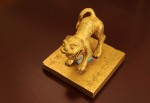 It all started with a looter. He, like everyone else in the region, knew the legend of the great treasure of Zhang Xianzhong which had sunk with all his ships in the river. With the Minjiang less than 10 feet deep, the looter, who happened to be an experienced diver, decided to have a look around in the dark of night to see if he might get his hands on a little illegally obtained cultural heritage. He found a gold tiger first, then an inscribed square piece, also gold, with four little divots that the tiger’s feet fit into perfectly. The inscription confirmed it was a gold seal (the tiger was its handle) made in lunar November, 1643, and bearing the title “Grand Marshal of Yongchang,” one of Zhang’s honorifics. He also found incredibly rare gold and silver books, ingots, coins and several other treasures, all of which he sold to an unscrupulous collector for 13,600,000 yuan (ca. $2,000,000).
It all started with a looter. He, like everyone else in the region, knew the legend of the great treasure of Zhang Xianzhong which had sunk with all his ships in the river. With the Minjiang less than 10 feet deep, the looter, who happened to be an experienced diver, decided to have a look around in the dark of night to see if he might get his hands on a little illegally obtained cultural heritage. He found a gold tiger first, then an inscribed square piece, also gold, with four little divots that the tiger’s feet fit into perfectly. The inscription confirmed it was a gold seal (the tiger was its handle) made in lunar November, 1643, and bearing the title “Grand Marshal of Yongchang,” one of Zhang’s honorifics. He also found incredibly rare gold and silver books, ingots, coins and several other treasures, all of which he sold to an unscrupulous collector for 13,600,000 yuan (ca. $2,000,000).
 More precious objects from this period began to appear on the black market. Police investigated and last fall were able to bust 10 artifact looting gangs and 70 traffickers and recover hundreds of artifacts of significant historical import. It was the largest looting case ever cracked in China. So, with the scofflaws apprehended and their contraband found, cultural heritage authorities turned their collective unblinking eye to the find site of some of the most important objects. Time for the professionals to get a turn.
More precious objects from this period began to appear on the black market. Police investigated and last fall were able to bust 10 artifact looting gangs and 70 traffickers and recover hundreds of artifacts of significant historical import. It was the largest looting case ever cracked in China. So, with the scofflaws apprehended and their contraband found, cultural heritage authorities turned their collective unblinking eye to the find site of some of the most important objects. Time for the professionals to get a turn.
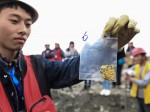 The ambitious excavation project began in January with the arrival of the dry season. Water was pumped out of the river, leaving a passable but very mucky riverbed. The archaeological team then had to dig down five meters (16’5″) beneath the surface of the riverbed before they literally struck gold. In the two months since excavations began, the team has unearthed more than 10,000 objects. The inscriptions on several of them point to their having been either produced under the aegis of Zhang Xianzhong or stolen by him during his long commitment to raiding the valuables of Ming Dynasty (1368-1644) palaces. They even found an item that matched a description in the Qing Dynasty records as having been used by Zhang: a tree trunk split lengthwise, hollowed out, filled with silver ingots and then clamped back together with iron or copper shanks.
The ambitious excavation project began in January with the arrival of the dry season. Water was pumped out of the river, leaving a passable but very mucky riverbed. The archaeological team then had to dig down five meters (16’5″) beneath the surface of the riverbed before they literally struck gold. In the two months since excavations began, the team has unearthed more than 10,000 objects. The inscriptions on several of them point to their having been either produced under the aegis of Zhang Xianzhong or stolen by him during his long commitment to raiding the valuables of Ming Dynasty (1368-1644) palaces. They even found an item that matched a description in the Qing Dynasty records as having been used by Zhang: a tree trunk split lengthwise, hollowed out, filled with silver ingots and then clamped back together with iron or copper shanks.
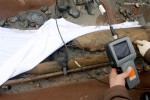 Zhang Xianzhong, known as Yellow Tiger after his complexion and his strong “tiger jaw,” was born in poverty in Shaanxi Province in 1606. He joined the army of the Ming Dynasty, but he wasn’t great at following orders and soon found himself with a death sentence hanging over his head for breaking military rules. He was spared by a superior officer who was swayed by his height and strength, but by 1630 Zhang was officially over it and went AWOL.
Zhang Xianzhong, known as Yellow Tiger after his complexion and his strong “tiger jaw,” was born in poverty in Shaanxi Province in 1606. He joined the army of the Ming Dynasty, but he wasn’t great at following orders and soon found himself with a death sentence hanging over his head for breaking military rules. He was spared by a superior officer who was swayed by his height and strength, but by 1630 Zhang was officially over it and went AWOL.
 He joined a peasant revolt that was then spreading all over the country, spurred by the Ming administration’s oppressive taxation during a time of famine and drought. He carved out a space for himself as leader of a group of rebels in his home province of Shaanxi. Seven years later, he had an army of 300,000 at his command. While suffering occasional defeats, one a very big one, at the hands of Ming Dynasty armies, he and his forces won more than they lost, and they collected great gobs of loot along the way.
He joined a peasant revolt that was then spreading all over the country, spurred by the Ming administration’s oppressive taxation during a time of famine and drought. He carved out a space for himself as leader of a group of rebels in his home province of Shaanxi. Seven years later, he had an army of 300,000 at his command. While suffering occasional defeats, one a very big one, at the hands of Ming Dynasty armies, he and his forces won more than they lost, and they collected great gobs of loot along the way.
In 1644, the year of the fall of the Ming Dynasty, Zhang went for the big score. He and 100,000 of his men conquered Sichuan. All of it. In September of that year, Zhang’s forces took Chengdu. He crowned himself the first king of the Daxi Dynasty and made Chengdu his capital. The good times didn’t last long. In the spring of 1645, pro-Ming troops retook Chongqing and in a classic piece of projection, Zhang started seeing conspiracy and rebellion everywhere. He decided to fight the seditious elements in his “kingdom” with a campaign of terror. Piles of body parts, flaying and killing became the order of the day.
It’s difficult to know precisely how many people he killed, but according to Jesuit priests who had worked for him in the beginning when it seemed like he would be a benevolent ruler, only a handful of people made it out of Sichuan alive. The only hard figures we have come from census records. The 1578 Ming census, the last we have for Sichuan before Zhang, recorded a population of 3,102,073. In 1661, there were a grand total of 16,096 men registered in Sichuan. The province was depopulated on a massive scale, that much is certain, and the blood of many was on Zhang’s hands, but there was a lot of conflict in the region before and after Zhang’s very brief rule, and widespread famine also must have taken a great toll on the populace.
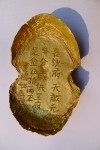 In October of 1646, with a new and vigorous enemy, the army of the Manchu Qing Dynasty, coming for him, Zhang decided to leave Sichuan with a quickness and head back home. He loaded 1,000 boats with all the cash and treasures he’d accumulated over years of raids and conquest and sent them south to Shaanxi. The recently unearthed ship only made it about 50 miles from Chengdu before sinking. In July 1647, Zhang’s army and allies clashed with Manchu forces. He either died in this battle, or he fled with his troops on his treasure-laden ships which then sank either because they were set on fire by the enemy or because in the chaos of retreat, the vessels crashed into each other and went down.
In October of 1646, with a new and vigorous enemy, the army of the Manchu Qing Dynasty, coming for him, Zhang decided to leave Sichuan with a quickness and head back home. He loaded 1,000 boats with all the cash and treasures he’d accumulated over years of raids and conquest and sent them south to Shaanxi. The recently unearthed ship only made it about 50 miles from Chengdu before sinking. In July 1647, Zhang’s army and allies clashed with Manchu forces. He either died in this battle, or he fled with his troops on his treasure-laden ships which then sank either because they were set on fire by the enemy or because in the chaos of retreat, the vessels crashed into each other and went down.
“The objects have helped identify the area where the battle was fought and are direct evidence of this historical event,” said Wang Wei, a Chinese archaeologist. […]
“The items are extremely valuable to science, history and art. They are of great significance for research into the political,economic, [sic] military and social lives of the Ming Dynasty,” said Li Boqian,an [sic] archaeologist from Peking University.
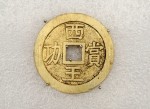 The excavation will continue through April and archaeologists fully expect to find more of Zhang’s not-quite-legendary-after-all lost treasure.
The excavation will continue through April and archaeologists fully expect to find more of Zhang’s not-quite-legendary-after-all lost treasure.
This news story has the best views of the excavation and a small fraction of the artifacts recovered I could find:
[youtube=https://youtu.be/OldLfbNG8qg&w=430]
“The 1578 Ming census, the last we have for Sichuan before Zhang, recorded a population of 3,102,073. In 1661, there were a grand total of 16,096 men registered in Sichuan.”
Mao wasn’t the first, eh?
I had read about this elsewhere recently and wondered how they’d managed to keep the river out while working – thank you for the photo and wow, that is one massive dig.